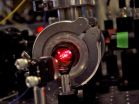(Press-News.org) (SALT LAKE CITY)—University of Utah scientists have developed a genetically engineered line of mice that is expected to open the door to new research on epilepsy, Alzheimer's and other diseases.
The mice carry a protein marker, which changes in degree of fluorescence in response to different calcium levels. This will allow many cell types, including cells called astrocytes and microglia, to be studied in a new way.
"This is opening up the possibility to decipher how the brain works," said Petr Tvrdik, Ph.D., a research fellow in human genetics and a senior author on the study.
The research was published Aug. 14, 2014, in Neuron, a world-leading neuroscience journal. The work is the result of a three-year study involving multiple labs connected with The Brain Institute at the University of Utah. The lead author is J. Michael Gee, who is pursuing both a medical degree and a graduate degree in bioengineering at the university.
"We're really in the era of team science," said John White, Ph.D., professor of bioengineering, executive director of the Brain Institute and the study's corresponding author.
With the new mouse line, scientists can use a laser-based fluorescence microscope to study the calcium indicator in the glial cells of the living mouse, either when the mouse is anesthetized or awake. Calcium is studied because it is an important signaling molecule in the body and it can reveal how well the brain is functioning.
Using this method, the scientists are essentially creating a window into the working brain to study the interactions between neurons, astrocytes and microglia.
"We believe this will give us new insights for treatments of epilepsy and for new views of how the immune system of the brain works," White said.
About one-third of the 3 million Americans estimated to have epilepsy lack adequate treatment to manage the disease.
Describing a long-standing collaboration with fellow university researcher and professor of pharmacology and toxicology Karen Wilcox, Ph.D., White said, "We believe the glial cells are malfunctioning in epilepsy. What we're trying to do is find out in what ways astrocytes participate in the disease."
This research is expected to lead to new classes of drugs.
The ability to track calcium changes in microglial cells will also open up the possibility of studying inflammatory diseases of the brain. Every neurological disease, including Multiple Sclerosis and Alzheimer's, appears to include components of inflammation, the scientists said.
"Live imaging and monitoring microglial activity and responses to inflammation was not possible before," said Tvrdik, particularly in living animals. In the past, researchers studied post-mortem tissue or relied on invasive approaches using synthetic dyes.
INFORMATION:
Authors of the article, "Imaging Activity in Neurons and Glia with a Polr2a-based and Cre-dependent GCaMP5G- IRES-tdTomato Reporter Mouse," are:
J. Michael Gee, Nathan A. Smith, Fernando R. Fernandez, Michael N. Economo, Daniela Brunert, Markus Rothermel, S. Craig Morris, Amy Talbot, Sierra Palumbos, Jennifer Ichida,
Jason D. Shepherd, Peter J. West, Matt Wachowiak, Karen S. Wilcox, John A. White and Petr Tvrdik.
Mario R. Capecchi, Ph.D., distinguished professor of human genetics and biology and 2007 recipient of the Nobel Prize in physiology or medicine, also contributed to the paper.
Mouse model for epilepsy, Alzheimer's gives window into the working brain
Mice carry a calcium protein marker
2014-08-21
ELSE PRESS RELEASES FROM THIS DATE:
Hacking Gmail with 92 percent success
2014-08-21
RIVERSIDE, Calif. — A team of researchers, including an assistant professor at the University of California, Riverside Bourns College of Engineering, have identified a weakness believed to exist in Android, Windows and iOS mobile operating systems that could be used to obtain personal information from unsuspecting users. They demonstrated the hack in an Android phone.
The researchers tested the method and found it was successful between 82 percent and 92 percent of the time on six of the seven popular apps they tested. Among the apps they easily hacked were Gmail, CHASE ...
Researchers identify potential risk factors for urinary tract infections in young girls
2014-08-21
Winston-Salem, N.C. – August, 21, 2014 – Young girls with an intense, red, itchy rash on their outer genital organs may be at increased risk of developing urinary tract infections (UTIs), according to new research from Wake Forest Baptist Medical Center. The treatment may be as simple as better hygiene and avoiding potential irritants such as bubble baths and swimming pools.
"Vulvitis is a common condition affecting women and girls of all ages," said senior author Steve J. Hodges, M.D., associate professor of urology at Wake Forest Baptist. "We found that girls with ...
Difficulty assessing effort drives motivation deficits in schizophrenia, study finds
2014-08-21
SAN FRANCISCO, Aug. 21, 2014 – Individuals with schizophrenia often have trouble engaging in daily tasks or setting goals for themselves, and a new study from San Francisco State University suggests the reason might be their difficulty in assessing the amount of effort required to complete tasks.
The research, detailed in an article published this week in the Journal of Abnormal Psychology, can assist health professionals in countering motivation deficits among patients with schizophrenia and help those patients function normally by breaking up larger, complex tasks into ...
A NASA satellite double-take at Hurricane Lowell
2014-08-21
Lowell is now a large hurricane in the Eastern Pacific and NASA's Aqua and Terra satellites double-teamed it to provide infrared and radar data to scientists. Lowell strengthened into a hurricane during the morning hours of August 21.
When NASA's Aqua satellite passed over Lowell on August 20 at 21:05 UTC (4:05 p.m. EDT), the Atmospheric Infrared Sounder got an infrared look at Lowell's cloud top temperatures when it was still a tropical storm. AIRS showed a very thick band of thunderstorms surrounding the center of circulation and what appeared to be a very small cloud-free ...
Researchers examine impact of race and ethnicity in motor complete spinal cord injury
2014-08-21
West Orange, NJ. August 21, 2014. Researchers have published a study examining racial and ethnic influences in the outcomes of patients with motor complete spinal cord injury (SCI). The article, "Racial and ethnic disparities in functioning at discharge and follow-up among patients with motor complete SCI," was published online ahead of print on August 2 by the Archives of Physical Medicine & Rehabilitation (doi: 10.1016/j.apmr.2014.07.398). Findings included small but significant differences in self-care and mobility at discharge; no differences were apparent at 1-year ...
Reading 'Fifty Shades' linked to unhealthy behaviors
2014-08-21
EAST LANSING, Mich. --- Young adult women who read "Fifty Shades of Grey" are more likely than nonreaders to exhibit signs of eating disorders and have a verbally abusive partner, finds a new study led by a Michigan State University researcher.
Further, women who read all three books in the blockbuster "Fifty Shades" erotic romance series are at increased risk of engaging in binge drinking and having multiple sex partners.
All are known risks associated with being in an abusive relationship, much like the lead character, Anastasia, is in "Fifty Shades," said Amy Bonomi, ...
Yale's cool molecules
2014-08-21
New Haven, Conn. – It's official. Yale physicists have chilled the world's coolest molecules.
The tiny titans in question are bits of strontium monofluoride, dropped to 2.5 thousandths of a degree above absolute zero through a laser cooling and isolating process called magneto-optical trapping (MOT). They are the coldest molecules ever achieved through direct cooling, and they represent a physics milestone likely to prompt new research in areas ranging from quantum chemistry to tests of the most basic theories in particle physics.
"We can start studying chemical reactions ...
Influenced by self-interest, humans less concerned about inequity to others
2014-08-21
ATLANTA—Strongly influenced by their self-interest, humans do not protest being overcompensated, even when there are no consequences, researchers in Georgia State University's Brains and Behavior Program have found.
This could imply that humans are less concerned than previously believed about the inequity of others, researchers said. Their findings are published in the journal Brain Connectivity. These findings suggest humans' sense of unfairness is affected by their self-interest, indicating the interest humans show in others' outcomes is a recently evolved propensity.
It ...
Women's health and Fifty Shades: Increased risks for young adult readers?
2014-08-21
New Rochelle, NY, August 21, 2014—Popular fiction that normalizes and glamorizes violence against women, such as the blockbuster Fifty Shades series, may be associated with a greater risk of potentially harmful health behaviors and risks. The results of a provocative new study are presented in the article "Fiction or Not? Fifty Shades Is Associated with Health Risks in Adolescent and Young Adult Females," published in Journal of Women's Health, a peer-reviewed publication from Mary Ann Liebert, Inc., publishers. The article is available free on the Journal of Women's Health ...
AAAS: Sri Lanka images show no significant increase in public facilities, despite promises
2014-08-21
Thousands of Sri Lankans remain refugees five years after a long civil war, and satellite-image analysis seems to reveal many new housing-like structures and development in a military zone in the northern part of the country. However, the analysis also shows no significant increase in civic facilities despite government claims that it has seized the land for public use.
The analysis, completed by the nonprofit, nonpartisan American Association for the Advancement of Science (AAAS), suggests a sharp increase in the number of residential housing-type structures within the ...
LAST 30 PRESS RELEASES:
Eye for trouble: Automated counting for chromosome issues under the microscope
The vast majority of US rivers lack any protections from human activities, new research finds
Ultrasound-responsive in situ antigen "nanocatchers" open a new paradigm for personalized tumor immunotherapy
Environmental “superbugs” in our rivers and soils: new one health review warns of growing antimicrobial resistance crisis
Triple threat in greenhouse farming: how heavy metals, microplastics, and antibiotic resistance genes unite to challenge sustainable food production
Earthworms turn manure into a powerful tool against antibiotic resistance
AI turns water into an early warning network for hidden biological pollutants
Hidden hotspots on “green” plastics: biodegradable and conventional plastics shape very different antibiotic resistance risks in river microbiomes
Engineered biochar enzyme system clears toxic phenolic acids and restores pepper seed germination in continuous cropping soils
Retail therapy fail? Online shopping linked to stress, says study
How well-meaning allies can increase stress for marginalized people
Commercially viable biomanufacturing: designer yeast turns sugar into lucrative chemical 3-HP
Control valve discovered in gut’s plumbing system
George Mason University leads phase 2 clinical trial for pill to help maintain weight loss after GLP-1s
Hop to it: research from Shedd Aquarium tracks conch movement to set new conservation guidance
Weight loss drugs and bariatric surgery improve the body’s fat ‘balance:’ study
The Age of Fishes began with mass death
TB harnesses part of immune defense system to cause infection
Important new source of oxidation in the atmosphere found
A tug-of-war explains a decades-old question about how bacteria swim
Strengthened immune defense against cancer
Engineering the development of the pancreas
The Journal of Nuclear Medicine ahead-of-print tip sheet: Jan. 9, 2026
Mount Sinai researchers help create largest immune cell atlas of bone marrow in multiple myeloma patients
Why it is so hard to get started on an unpleasant task: Scientists identify a “motivation brake”
Body composition changes after bariatric surgery or treatment with GLP-1 receptor agonists
Targeted regulation of abortion providers laws and pregnancies conceived through fertility treatment
Press registration is now open for the 2026 ACMG Annual Clinical Genetics Meeting
Understanding sex-based differences and the role of bone morphogenetic protein signaling in Alzheimer’s disease
Breakthrough in thin-film electrolytes pushes solid oxide fuel cells forward
[Press-News.org] Mouse model for epilepsy, Alzheimer's gives window into the working brainMice carry a calcium protein marker






